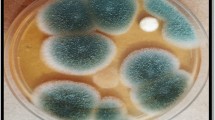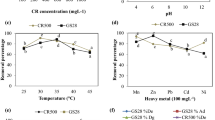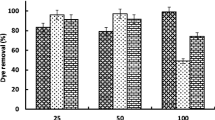Abstract
In the present study, a widely used reactive dye, Color Index (C.I.) Reactive Blue 268 was utilized for mycoremediation by Aspergillus fumigatus isolated from textile effluent. Complete decolorization of the test dye (0.1 g L−1) was recorded within 6 days of static incubation at 27 °C in Czapek Dox broth (CDB). However, the isolate was unable to utilize the dye as a sole source of energy in Czapek Dox agar and CDB in absence of sucrose and obligate requirement of a labile carbon source, i.e., sucrose needed for induction of decolorization. Biosorption seems to play the pivotal role in decolorization as evident by coloring of the fungal biomass as that of dye color. The optimal conditions for the highest decolorization were found at 30 °C and pH 6.0 with 6-day-old inoculums supplemented with sucrose (10 g L−1) and ammonium chloride (2 g L−1) as a carbon and nitrogen source, respectively. The response of the isolate to increasing dye concentrations was found to be growth inhibitory. Surprisingly, about 65 % of dye decolorization was recorded with heat-inactivated biomass powder within 6 days of static incubation supporting the fact of fungal biosorption. Results of this study have established the candidature of the isolate for biotechnological removal of dyes from disreputable dying effluents.










Similar content being viewed by others
References
Bhattacharya S, Das A, Mangai G, Vignesh K, Sangeetha J (2011) Mycoremediation of Congo red dye by filamentous fungi. Braz J Microbiol 42:1526–1536
Cetin D, Donmez G (2006) Decolorization of reactive dyes by mixed cultures isolated from textile effluent under anaerobic condition. Enzyme Microb Technol 38:926–930
Chen KC, Wu JY, Liou DJ, Hwang SCJ (2003) Decolorization of the textile dyes by newly isolated bacterial strains. J Biotechnol 101:57–68
Chung KT, Cerniglia CE (1992) Mutagenecity of azo dyes: structure activity relationships. Mutat Res 277(3):201–220
dos Santos AB, Cervantes FJ, van Lier JB (2007) Review paper on current technologies for decolorization of textile wastewaters: perspectives for anaerobic biotechnology. Bioresour Technol 98(12):2369–2385
Eelko GS, Natal AWR, Theo VC (2000) The role of ammonia metabolism in nitrogen catabolite repression in Saccharomyces cerevisiae. FEMS Microbiol Rev 24:67–83
Gillman JK (1957) A manual of soil fungi. Iowa State University Press, Ames
Hu TL, Wu SC (2001) Assessment of the effect of azo dye Rp2B on the growth of nitrogen fixing cyanobacterium Anabena sp. Bioresour Technol 77(1):93–95
Jin XC, Liu GQ, Xu ZH, Tao WY (2007) Decolorization of a dye industry effluent by Aspergillus fumigatus XC6. Appl Microbiol Biotechnol 74(1):239–243
Khelifi E, Ayed L, Bouallagui H, Touhami Y, Hamdi M (2009) Effect of nitrogen and carbon sources on indigo and Congo red decolorization by Aspergillus alliaceus strain 121C. J Hazard Mater 163:1056–1062
Knapp SJ, Zhang F, Tapley NK (1997) Decolourisation of Orange II by a wood-rotting fungus. J Chem Technol Biotechnol 69:289–296
Kumar K, Dastidar MG, Sreekrishnan TR (2009) Effect of process parameters on aerobic decolourization of reactive azo dye using mixed culture. World Acad Sci Eng Technol 58:962–965
Kumari K, Abraham E (2006) Biosorption of anionic textile dyes by nonviable biomass of fungi and yeast. Bioresour Technol 98:1704–1710
Mahony TO, Guibal E, Tobin JM (2002) Reactive dye biosorption by Rhizopus arrhizus biomass. Enzyme Microb Technol 31(4):456–463
Martorell MM, Pajot HF, Figueroa LIC (2012) Dye-decolorizing yeasts isolated from Las Yungas rainforest. Dye assimilation and removal used as selection criteria. Int Biodeterior Biodegrad 66:25–32
Netpradist S, Thiravetyan P, Towprayoon S (2007) Application of ‘waste’ metal hydroxide sludge for adsorption of azo reactive dyes. Water Res 37(4):763–772
Pierce J (1994) Colour in textile effluents—the origins of the problem. J Soc Dyers Color 110:131–133
Robinson T, McMullan G, Marchant R (2001) Remediation of dyes in textile effluent: a critical review on current treatment technologies with a proposed alternative. Bioresour Technol 77:247–255
Saratale RG, Saratale GD, Chang JS, Govindwar SP (2010) Decolorization and biodegradation of reactive dyes and dye wastewater by a developed bacterial consortium. Biodegradation 21:999–1015
Sarnaik S, Kanekar P (1999) Biodegradation of methyl violet by Pseudomonas mendocina MCM B-402. Appl Microbiol Biotechnol 52(2):251–254
Sumathi S, Manju BS (2000) Uptake of reactive textile dyes by Aspergillus foetidus. Enzyme Microb Technol 27:347–355
Volesky B (1990) Biosorption by fungal biomass. In: Volesky B (ed) Biosorption of heavy metals. CRC Press, Boca Raton, pp 139–171
Wu J, Yu HQ (2006) Biosorption of 2, 4-dichlorophenol from aqueous solution by Phanerochaete chrysosporium biomass: isotherms, kinetics and thermodynamics. J Hazard Mater 137:498–508
Wuhrmann K, Mechsner KL, Kappeler T (1980) Investigation on rate determining factors in the microbial reduction of azo dyes. Eur J Appl Microb 9:325–338
Xie S, Liu JX, Li L, Qiao CL (2009) Biodegradation of malathion by Acinetobacter johnsonii MA19 and optimization of cometabolism substrates. J Environ Sci 21:76–82
Acknowledgments
The authors are grateful to the Ministry of Science and Technology, Bangladesh, for financial assistant under the project “Bio-decolorization of textile reactive dyes” [Grant Number: 39.012.002.01.03.019.2013-281(145)] in the fiscal year 2013–2014.
Author information
Authors and Affiliations
Corresponding author
Ethics declarations
Conflict of interest
The authors declared that they have no conflict of interest.
Additional information
Editorial responsibility: M. Abbaspour.
Rights and permissions
About this article
Cite this article
Ekramul Karim, M., Dhar, K. & Towhid Hossain, M. Co-metabolic decolorization of a textile reactive dye by Aspergillus fumigatus . Int. J. Environ. Sci. Technol. 14, 177–186 (2017). https://doi.org/10.1007/s13762-016-1136-7
Received:
Revised:
Accepted:
Published:
Issue Date:
DOI: https://doi.org/10.1007/s13762-016-1136-7




